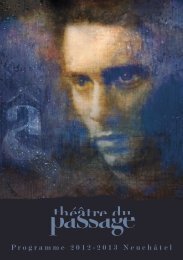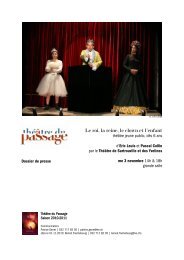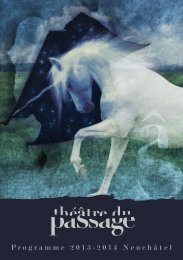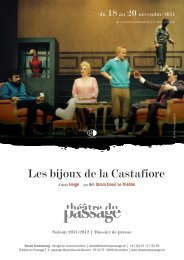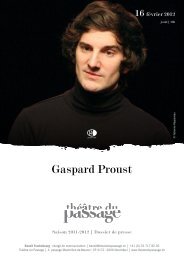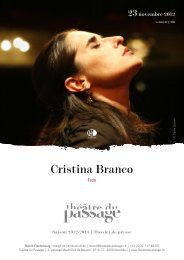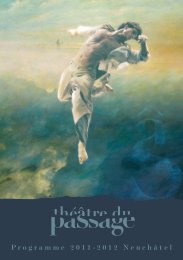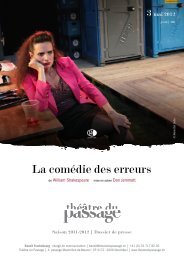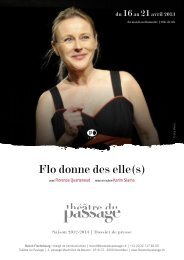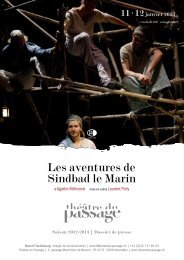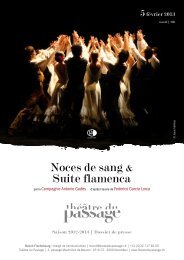BIOGRAPHIE COLLABORATEURS - Théâtre du Passage
BIOGRAPHIE COLLABORATEURS - Théâtre du Passage
BIOGRAPHIE COLLABORATEURS - Théâtre du Passage
Create successful ePaper yourself
Turn your PDF publications into a flip-book with our unique Google optimized e-Paper software.
Strictly speaking, the theme of transformation of collective cultural memory has also become the basis of"Edouard Lock’s New Work," which is overlaid onto the music of two major Baroque operas, Purcell’s Dido andAeneas and Gluck’s Orfeo and Eurydice, which have been deconstructed and reassembled by the contemporarycomposer Gavin Bryars, with a live piano, violin and cello replacing the orchestra, and a moaning saxophonereplacing the singers’ voices. There’s no point in looking for the operas’ mythological heroes (or the subjects asone may know them) in Lock’s ballet — spectators use their own knowledge of the works to construct their ownmyth based on the choreographed fragments that hit them like the luminous pulsations of a strobe light — that is,of course, if their brains have the time to decipher all the signals hitting the retinas of their eyes.Mine didn’t. As to what to make of the gigantic video portraits that were lowered from the rafters in threesections (a young ballerina and an old lady, who have been prodigiously made up) — that they are meant toserve as metaphors of the Styx dividing the world between the living and the dead — I didn’t guess until I hadleft the theatre. The same goes for the kindly "old woman" with the evil look and hands primly folded on her lap,which may embody the three-headed Cerberus keeping watch over its victims. The show also featured twostately ballerinas, sternly turning on pointe, like ancient parks dancing the thread of the fates; and brutal heroesflinging away women and stepping over them on their way to their own glory, with even the energy ofunrelenting passion reaching mythological proportions.Among the main roles, there are at least three worthy of mention: the furious Talia Evtushenko, clinging to menand abandoned by Dido; fragile and passionless like the shadow of Eurydice, Mi Deng — her partners jugglingher body like bandits fleeing pursuers with a valuable statuette. And Diana Vishneva, whose final, dynamic andpathetic dance strikes the pose of the Dying Swan — a tribute to all the perished heroes of classical culture.On the outer darkness of the stage, which is split into sectors with cones of dazzling white light —such that theaction is thrown from circle to circle while losing what remains of definition — it is impossible not only to craftthe show’s innumerable details into the mosaic of a distinct message but even to grasp those details. And, infact, this is the concept of the crafty choreographer, the inventor of "invisible dance" — that which remainsimpervious to examination and to which each spectator is called upon to bring his or her own imagination, whilereaching back into cultural memory. If, of course, there is such a thing.




